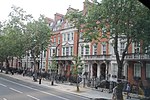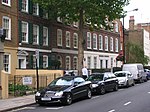Plumbers Arms, Belgravia
19th-century architecture in the United KingdomBelgraviaBuildings and structures completed in the 19th centuryGrade II listed pubs in the City of WestminsterLondon building and structure stubs ... and 3 more
Pub stubsUnited Kingdom listed building stubsUse British English from September 2014

The Plumbers Arms is a Grade II listed public house at 14 Lower Belgrave Street, Belgravia, London SW1.It is where Lady Lucan burst in on the evening of 7 November 1974, covered in blood and fearing for her own life, after discovering that her husband, Lord Lucan, had murdered their nanny, Sandra Rivett. (Lord Lucan's subsequent disappearance means this case has never been tried in court, but his wife identified him as her assailant and he was named as the murderer at the coroner's inquest). It was built mid-19th century.
Excerpt from the Wikipedia article Plumbers Arms, Belgravia (License: CC BY-SA 3.0, Authors, Images).Plumbers Arms, Belgravia
Lower Belgrave Street, London Belgravia
Geographical coordinates (GPS) Address External links Nearby Places Show on map
Geographical coordinates (GPS)
| Latitude | Longitude |
|---|---|
| N 51.4965 ° | E -0.1476 ° |
Address
The Plumbers Arms
Lower Belgrave Street 14
SW1W 0LN London, Belgravia
England, United Kingdom
Open on Google Maps










